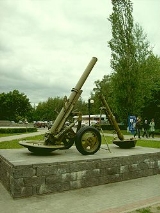
160mm Mortar M1943
Encyclopedia
The Soviet 160 mm Mortar M1943 was a smoothbore breech loading heavy mortar
which fired a massive 160 mm bomb. The M1943 (also called the MT-13) was the heaviest mortar used by Soviet troops in World War II
. Around 535 of these weapons were fielded with Soviet forces during the war. It was replaced in Soviet service after World War II by the M-160 mortar of the same caliber.
, it soon became apparent that drop-loading a 40 kg bomb into a 3 meter high tube would be too difficult for any man to do. It was redesigned into a breech loading weapon
, and contains a substantial recoil system to soak up the massive shock of firing a 160 mm bomb and prevent the baseplate from burying itself too deeply.
The barrel
sits in a cradle
which is attached to a baseplate and tripod
. To load the weapon, the barrel is hinged forward which exposes the rear end of the tube. The bomb is then loaded, retained in place by a catch, and the barrel is swung back into the cradle, which in effect closes the breech.
Because of the weight of the mortar, it is equipped with wheels and is designed to be towed by a motor-driven vehicle.
Mortar (weapon)
A mortar is an indirect fire weapon that fires explosive projectiles known as bombs at low velocities, short ranges, and high-arcing ballistic trajectories. It is typically muzzle-loading and has a barrel length less than 15 times its caliber....
which fired a massive 160 mm bomb. The M1943 (also called the MT-13) was the heaviest mortar used by Soviet troops in World War II
World War II
World War II, or the Second World War , was a global conflict lasting from 1939 to 1945, involving most of the world's nations—including all of the great powers—eventually forming two opposing military alliances: the Allies and the Axis...
. Around 535 of these weapons were fielded with Soviet forces during the war. It was replaced in Soviet service after World War II by the M-160 mortar of the same caliber.
Description
Originally a simple scaling-up of the 120 mm M1938 mortarM1938 mortar
The Soviet M1938 120-millimeter mortar was the first modern 120 mm mortar developed by any country, entering production in 1939. The Red Army made significant use of its heavy caliber by treating it as an artillery piece in World War II. The Germans were impressed by the weapon and adopted it...
, it soon became apparent that drop-loading a 40 kg bomb into a 3 meter high tube would be too difficult for any man to do. It was redesigned into a breech loading weapon
Weapon
A weapon, arm, or armament is a tool or instrument used with the aim of causing damage or harm to living beings or artificial structures or systems...
, and contains a substantial recoil system to soak up the massive shock of firing a 160 mm bomb and prevent the baseplate from burying itself too deeply.
The barrel
Gun barrel
A gun barrel is the tube, usually metal, through which a controlled explosion or rapid expansion of gases are released in order to propel a projectile out of the end at a high velocity....
sits in a cradle
Cradle
Cradle may refer to:Mechanical devices:*Bassinet, a small bed, often on rockers, in which babies and small children sleep* Ship cradle, supports a ship that is dry docked...
which is attached to a baseplate and tripod
Tripod
A tripod is a portable three-legged frame, used as a platform for supporting the weight and maintaining the stability of some other object. The word comes from the Greek tripous, meaning "three feet". A tripod provides stability against downward forces, horizontal forces and moments about the...
. To load the weapon, the barrel is hinged forward which exposes the rear end of the tube. The bomb is then loaded, retained in place by a catch, and the barrel is swung back into the cradle, which in effect closes the breech.
Because of the weight of the mortar, it is equipped with wheels and is designed to be towed by a motor-driven vehicle.
Tactical organization
The Soviet Army deployed the 160-mm mortar in brigades of 32 mortars each. The brigades were composed of four battalions of eight mortars each. Such brigades were part of the artillery divisions formed from 1944 onward (see Divisions of the Soviet Union 1917-1945).External links
- http://www.weaponblog.ru/group/vidy/voennaja_texnika/39451.html

